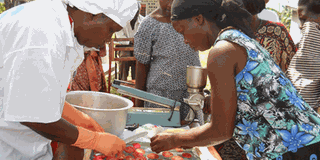Prime
Farmers' Diary: Improving food security by cutting food losses after harvest

A food scientist teaches farmers how to preserve tomatoes by solar drying. Photo by Michael J. Ssali.
What you need to know:
One of the many challenges the Ugandan smallholder farmer faces is safe storage of his or her harvest.
Most of us live in small and poorly constructed houses where we also keep the crops we harvest. Some of us even share our houses with domestic animals. Few of us have adequate granaries or stores for keeping the crops we harvest.
We then find ourselves in constant battle with insects, rats, and other rodents that invade to feed on the food we keep.
Storing crops
Often it is the goats and chicken we keep that damage or eat the maize, cassava, groundnuts and other crops we harvest and put under the sun to dry.
Some crops like maize and beans may tend to germinate once exposed to moisture. They may lose their taste and become unfit for human consumption.
When it rains before we have had enough time to remove the grain from the yard, not only will it absorb water but it could also be carried away by the run-off water.
Only a few of us have clean mats to dry the crops and instead dry them on bare ground, which sometimes reduces drying rates and exposes the food to contamination. Drying the crops on mats and on raised structures will prevent them from absorbing moisture from the ground.
Cut food losses
The crops on the raised structure will not be carried away by run-off rainwater and they will not be contaminated with soil and other impurities commonly found on the bare ground.
A Food and Agriculture Organisation statement, released early this month, called upon governments and all farming communities to join in the SAVE FOOD initiative; a global effort designed to cut down on food losses and waste.
It says: “Established in 2011, SAVE FOOD, the Global Initiative on Food Losses and Waste Reduction, aims to reduce the estimated 1.3 billion tonnes of food that is lost or wasted every year. Annual losses are valued at nearly $1t.
One-third of the food produced in the world for human consumption is thrown away or lost, as well as the natural resources used for its production.
Food losses and waste amounts to roughly $680b in industrialised countries and $310b in developing countries. In poor countries, food losses hit small farmers the hardest. Almost 65 per cent of those losses happen at the production, post harvest, and processing stages.”
We begin losing food from the time the crop is considered mature, through the harvesting period, during transportation from the field to our homes, during drying in the compound, during storage, and during transportation to the market.
Our farmers generally have limited access to helpful information and improved technology.
Timely harvesting
When the crops are mature and the farmer delays to harvest, they get attacked by birds. Some of them like bananas ripen and rot. Foodstuffs like groundnuts may be attacked by rodents. Thieves also steal the food crops causing losses to the farmer. Harvesting must be timely to avoid losses.
Grains like maize, millet and sorghum, and legumes like beans and groundnuts must be thoroughly dried for proper preservation. Keeping grain in a maize crib with rat guards or keeping a cat in the home may protect the maize.
Root crops like cassava, potatoes, and yams may remain in good condition for just a few days after harvest and farmers will often choose to harvest them when they want to cook them or at the time for taking them to the market. However there is a time limit beyond which they should not stay in the field.
Adding value
Cassava may be dried and grounded into flour, which may be stored for months. Some people these days cut potatoes into chips and fry them, which helps to preserve them.
Vegetables and fruits should be harvested and taken quickly to the market. Refrigeration facilities and efficient transport means to markets will help to minimise losses.
Many farmers’ groups organise seminars and invite experts to teach them about value addition to food. This involves making fruit juice and wine, sun drying fruits and vegetables or turning some vegetables into powder.
Some food losses occur during shelling and threshing and the famer must pay attention to some of these issues. How much of the grain is left on the maize comb? How much of the grain is spilled on the ground and left uncollected? During winnowing, especially when the smallholder farmer uses a mere basket; how much of the grain (like millet) gets blown away by the wind?




